An Improved Cloud Masking Method for GOCI Data over Turbid Coastal Waters
Abstract
1. Introduction
2. Materials and Methods
2.1. GOCI Data
2.2. An Improved Cloud Masking Method
- Step 1.
- calculate the Rayleigh-corrected reflectance at the four bands of 412 nm, 660 nm, 680 nm, and 865 nm;
- Step 2.
- calculate the according to Equation (1), which was proposed by Nordkvist et al.;
- Step 3.
- pixels satisfying either of the following two conditions (1 or 2) are masked as clouds:
- (1)
- and and ;
- (2)
- and and .
3. Results
3.1. Comparison of Four Cloud Masking Methods Using Selected Samples
3.2. Performance Comparison Over Typical Turbid Waters
3.3. Performance Comparison Over Other Areas
4. Discussion
5. Conclusions
Author Contributions
Funding
Institutional Review Board Statement
Informed Consent Statement
Acknowledgments
Conflicts of Interest
References
- Tsai, Y.-L.S.; Dietz, A.; Oppelt, N.; Kuenzer, C. Remote Sensing of Snow Cover Using Spaceborne SAR: A Review. Remote Sens. 2019, 11, 1456. [Google Scholar] [CrossRef]
- Jeppesen, J.H.; Jacobsen, R.H.; Inceoglu, F.; Toftegaard, T.S. A cloud detection algorithm for satellite imagery based on deep learning. Remote Sens. Environ. 2019, 229, 247–259. [Google Scholar] [CrossRef]
- Derrien, M.; Le Gleau, H. MSG/SEVIRI cloud mask and type from SAFNWC. Int. J. Remote Sens. 2005, 26, 4707–4732. [Google Scholar] [CrossRef]
- Lyapustin, A.; Wang, Y.; Frey, R. An automatic cloud mask algorithm based on time series of MODIS measurements. J. Geophys. Res. Atmos. 2008, 113. [Google Scholar] [CrossRef]
- Purbantoro, B.; Aminuddin, J.; Manago, N.; Toyoshima, K.; Lagrosas, N.; Sumantyo, J.T.S.; Kuze, H. Comparison of Aqua/Terra MODIS and Himawari-8 Satellite Data on Cloud Mask and Cloud Type Classification Using Split Window Algorithm. Remote Sens. 2019, 11, 2944. [Google Scholar] [CrossRef]
- Wilson, M.J.; Oreopoulos, L. Enhancing a Simple MODIS Cloud Mask Algorithm for the Landsat Data Continuity Mission. IEEE Trans. Geosci. Remote Sens. 2013, 51, 723–731. [Google Scholar] [CrossRef]
- Zhuge, X.; Zou, X.; Wang, Y. A Fast Cloud Detection Algorithm Applicable to Monitoring and Nowcasting of Daytime Cloud Systems. IEEE Trans. Geosci. Remote Sens. 2017, 55, 6111–6119. [Google Scholar] [CrossRef]
- Saunders, R.W.; Kriebel, K.T. An improved method for detecting clear sky and cloudy radiances from AVHRR data. Int. J. Remote Sens. 1988, 9, 123–150. [Google Scholar] [CrossRef]
- Kriebel, K.; Gesell, G.; Kaestner, M.; Mannstein, H. Cloud detection in AVHRR and ATSR data with APOLLO. In Proceedings of the Satellite Remote Sensing, Rome, Italy, 23 December 1994. [Google Scholar]
- Kriebel, K.T.; Gesell, G.; Kaestner, M.; Mannstein, H. The cloud analysis tool APOLLO: Improvements and validations. Int. J. Remote Sens. 2003, 24, 2389–2408. [Google Scholar] [CrossRef]
- Karlsson, K.G. Development of an operational cloud classification model. Int. J. Remote Sens. 1989, 10, 687–693. [Google Scholar] [CrossRef]
- Martins, J.V.; Tanré, D.; Remer, L.; Kaufman, Y.; Mattoo, S.; Levy, R. MODIS Cloud screening for remote sensing of aerosols over oceans using spatial variability. Geophys. Res. Lett. 2002, 29, MOD4-1–MOD4-4. [Google Scholar] [CrossRef]
- Zhu, Z.; Woodcock, C.E. Object-based cloud and cloud shadow detection in Landsat imagery. Remote Sens. Environ. 2012, 118, 83–94. [Google Scholar] [CrossRef]
- Breon, F.M.; Colzy, S. Cloud detection from the spaceborne POLDER instrument and validation against surface synoptic observations. J. Appl. Meteorol. 1999, 38, 777–785. [Google Scholar] [CrossRef]
- Benas, N.; Finkensieper, S.; Stengel, M.; van Zadelhoff, G.J.; Hanschmann, T.; Hollmann, R.; Meirink, J.F. The MSG-SEVIRI-based cloud property data record CLAAS-2. Earth Syst. Sci. Data 2017, 9, 415–434. [Google Scholar] [CrossRef]
- Li, C.; Ma, J.J.; Yang, P.; Li, Z.Q. Detection of cloud cover using dynamic thresholds and radiative transfer models from the polarization satellite image. J. Quant. Spectrosc. Radiat. Transf. 2019, 222–223, 196–214. [Google Scholar] [CrossRef]
- Spangenberg, D.A.; Doelling, D.R.; Chakrapani, V.; Minnis, P.; Uttal, T. Nighttime cloud detection over the Arctic using AVHRR data. In Proceedings of the Twelfth ARM Science Team Meeting Proceedings, St. Petersburg, FL, USA, 8–12 April 2002. [Google Scholar]
- Park, Y.-J.; Ahn, Y.; Han, H.; Yang, H.; Moon, J.; Ahn, J.; Lee, B.; Min, J.; Lee, S.; Kim, K.; et al. GOCI Level 2 Ocean Color Products (GDPS 1.3) Brief Algorithm Description; Korea Ocean Satellite Center: Busan Metropolitan City, Korea, 2014. [Google Scholar]
- Ackerman, S.A.; Strabala, K.I.; Menzel, W.P.; Frey, R.A.; Moeller, C.C.; Gumley, L.E. Discriminating clear sky from clouds with MODIS. J. Geophys. Res. Atmos. 1998, 103, 32141–32157. [Google Scholar] [CrossRef]
- Platnick, S.; King, M.D.; Ackerman, S.A.; Menzel, W.P.; Baum, B.A.; Riedi, J.C.; Frey, R.A. The MODIS cloud products: Algorithms and examples from Terra. IEEE Trans. Geosci. Remote Sens. 2003, 41, 459–473. [Google Scholar] [CrossRef]
- Remer, L.A.; Kaufman, Y.J.; Tanre, D.; Mattoo, S.; Chu, D.A.; Martins, J.V.; Li, R.R.; Ichoku, C.; Levy, R.C.; Kleidman, R.G.; et al. The MODIS aerosol algorithm, products, and validation. J. Atmos. Sci. 2005, 62, 947–973. [Google Scholar] [CrossRef]
- Choi, J.-K.; Park, Y.J.; Ahn, J.H.; Lim, H.-S.; Eom, J.; Ryu, J.-H. GOCI, the world’s first geostationary ocean color observation satellite, for the monitoring of temporal variability in coastal water turbidity. J. Geophys. Res. Ocean. 2012, 117. [Google Scholar] [CrossRef]
- Ruddick, K.G.; Ovidio, F.; Rijkeboer, M. Atmospheric correction of SeaWiFS imagery for turbid coastal and inland waters. Appl. Opt. 2000, 39, 897–912. [Google Scholar] [CrossRef]
- Arrigo, K.R.; McClain, C.R. Spring phytoplankton production in the western ross sea. Science 1994, 266, 261–263. [Google Scholar] [CrossRef]
- Banks, A.C.; Melin, F. An assessment of cloud masking schemes for satellite ocean colour data of marine optical extremes. Int. J. Remote Sens. 2015, 36, 797–821. [Google Scholar] [CrossRef]
- Banks, A.C.; Prunet, P.; Chimot, J.; Pina, P.; Donnadille, J.; Jeansou, E.; Lux, M.; Petihakis, G.; Korres, G.; Triantafyllou, G.; et al. A satellite ocean color observation operator system for eutrophication assessment in coastal waters. J. Mar. Syst. 2012, 94, S2–S15. [Google Scholar] [CrossRef]
- Hallegraeff, G.M. Ocean climate change, phytoplankton community responses, and harmful algal blooms: A formidable predictive challenge. J. Phycol. 2010, 46, 220–235. [Google Scholar] [CrossRef]
- Wang, M.; Shi, W. Cloud masking for ocean color data processing in the coastal regions. IEEE Trans. Geosci. Remote Sens. 2006, 44, 3196–3205. [Google Scholar] [CrossRef]
- Hudson, B.D.; Overeem, I.; Syvitski, J.P.M. A novel technique to detect turbid water and mask clouds in Greenland fjords. Int. J. Remote Sens. 2016, 37, 1730–1746. [Google Scholar] [CrossRef]
- Hu, C.; Carder, K.L.; Muller-Karger, F.E. Atmospheric correction of SeaWiFS imagery over turbid coastal waters: A practical method. Remote Sens. Environ. 2000, 74, 195–206. [Google Scholar] [CrossRef]
- Wang, M.; Shi, W.; Jiang, L. Atmospheric correction using near-infrared bands for satellite ocean color data processing in the turbid western Pacific region. Opt. Express 2012, 20, 741–753. [Google Scholar] [CrossRef] [PubMed]
- Nordkvist, K.; Loisel, H.; Gaurier, L.D. Cloud masking of SeaWiFS images over coastal waters using spectral variability. Opt. Express 2009, 17, 12246–12258. [Google Scholar] [CrossRef]
- Ishida, H.; Oishi, Y.; Morita, K.; Moriwaki, K.; Nakajima, T.Y. Development of a support vector machine based cloud detection method for MODIS with the adjustability to various conditions. Remote Sens. Environ. 2018, 205, 390–407. [Google Scholar] [CrossRef]
- Mahajan, S.; Fataniya, B. Cloud detection methodologies: Variants and development-a review. Complex Intell. Syst. 2020, 6, 251–261. [Google Scholar] [CrossRef]
- Chai, D.; Newsam, S.; Zhang, H.K.; Qiu, Y.; Huang, J. Cloud and cloud shadow detection in Landsat imagery based on deep convolutional neural networks. Remote Sens. Environ. 2019, 225, 307–316. [Google Scholar] [CrossRef]
- Qiu, S.; He, B.; Zhu, Z.; Liao, Z.; Quan, X. Improving Fmask cloud and cloud shadow detection in mountainous area for Landsats 4–8 images. Remote Sens. Environ. 2017, 199, 107–119. [Google Scholar] [CrossRef]
- Hughes, M.J.; Kennedy, R. High-Quality Cloud Masking of Landsat 8 Imagery Using Convolutional Neural Networks. Remote Sens. 2019, 11, 2591. [Google Scholar] [CrossRef]
- Park, J.H.; Inamori, T.; Hamaguchi, R.; Otsuki, K.; Kim, J.E.; Yamaoka, K. RGB Image Prioritization Using Convolutional Neural Network on a Microprocessor for Nanosatellites. Remote Sens. 2020, 12, 3941. [Google Scholar] [CrossRef]
- Yang, H.; Han, H.; Heo, J.; Jeong, J.; Lee, T.; Hu, W.; Kwak, S. Ocean Color Algorithm Development Environment for High-Speed Data Processing of GOCI-II. In Proceedings of the IGARSS 2018–2018 IEEE International Geoscience and Remote Sensing Symposium, Valencia, Spain, 22–27 July 2018; pp. 7968–7971. [Google Scholar]
- Lamquin, N.; Mazeran, C.; Doxaran, D.; Ryu, J.-H.; Park, Y.-J. Assessment of GOCI Radiometric Products using MERIS, MODIS and Field Measurements. Ocean Sci. J. 2012, 47, 287–311. [Google Scholar] [CrossRef]
- Ahn, J.-H.; Park, Y.-J.; Ryu, J.-H.; Lee, B.; Oh, I.S. Development of Atmospheric Correction Algorithm for Geostationary Ocean Color Imager (GOCI). Ocean Sci. J. 2012, 47, 247–259. [Google Scholar] [CrossRef]
- Gordon, H.R.; Wang, M.H. Retrieval of water-leaving radiance and aerosal optical-thickness over the oceans with SeaWiFS-a preliminary algorithm. Appl. Opt. 1994, 33, 443–452. [Google Scholar] [CrossRef]
- Ruddick, K.; Vanhellemont, Q.; Yan, J.; Neukermans, G.; Wei, G.; Shang, S. Variability of Suspended Particulate Matter in the Bohai Sea from the Geostationary Ocean Color Imager (GOCI). Ocean Sci. J. 2012, 47, 331–345. [Google Scholar] [CrossRef]
- Kim, J.B.; Park, J.-I.; Jung, C.-S.; Lee, P.-Y.; Lee, K.-S. Distributional range extension of the seagrass Halophila nipponica into coastal waters off the Korean peninsula. Aquat. Bot. 2009, 90, 269–272. [Google Scholar] [CrossRef]
- Alvera-Azcarate, A.; Vanhellemont, Q.; Ruddick, K.; Barth, A.; Beckers, J.-M. Analysis of high frequency geostationary ocean colour data using DINEOF. Estuar. Coast. Shelf Sci. 2015, 159, 28–36. [Google Scholar] [CrossRef]
- Liu, X.; Wang, M. Filling the Gaps of Missing Data in the Merged VIIRS SNPP/NOAA-20 Ocean Color Product Using the DINEOF Method. Remote Sens. 2019, 11, 178. [Google Scholar] [CrossRef]

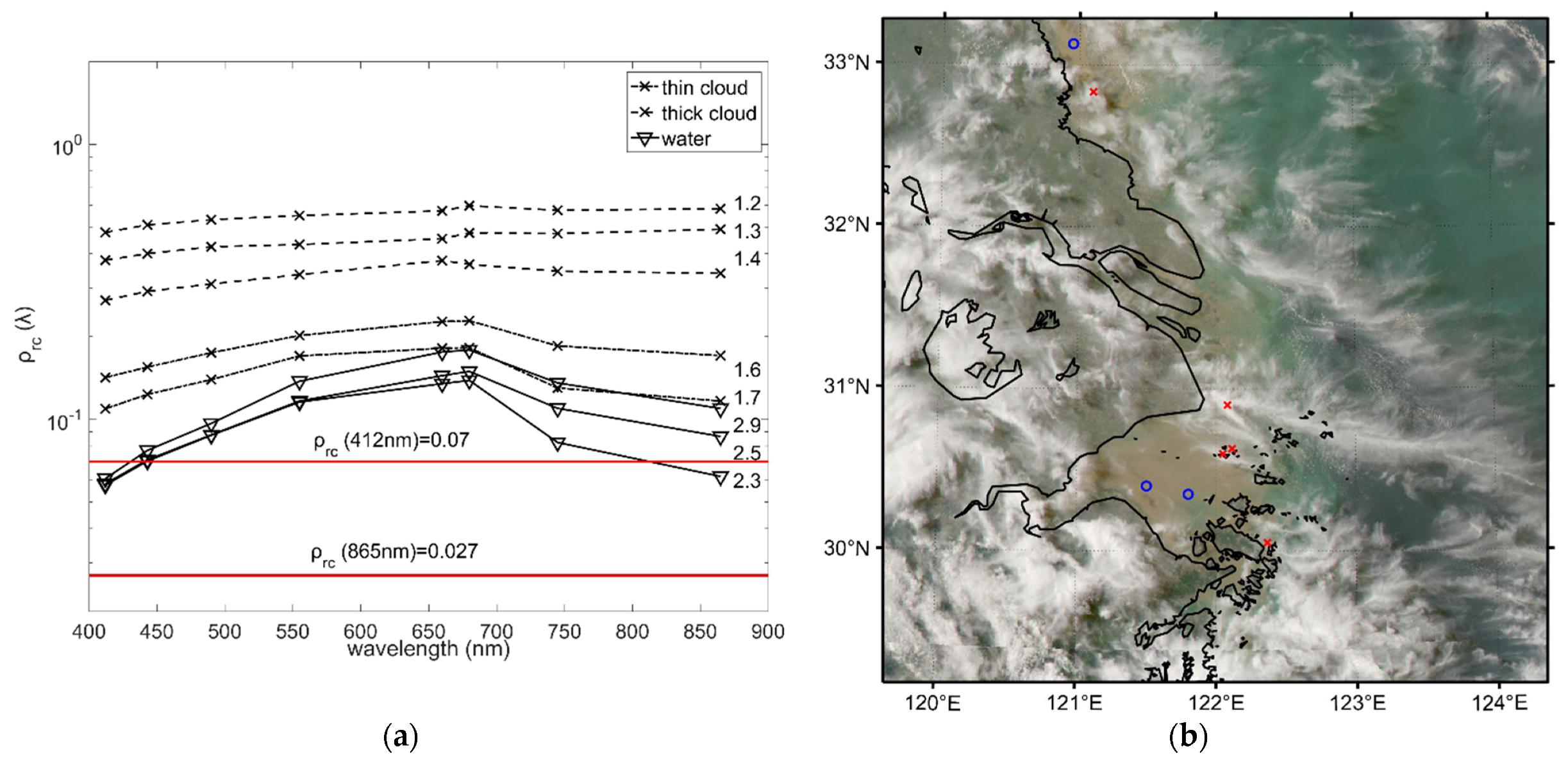

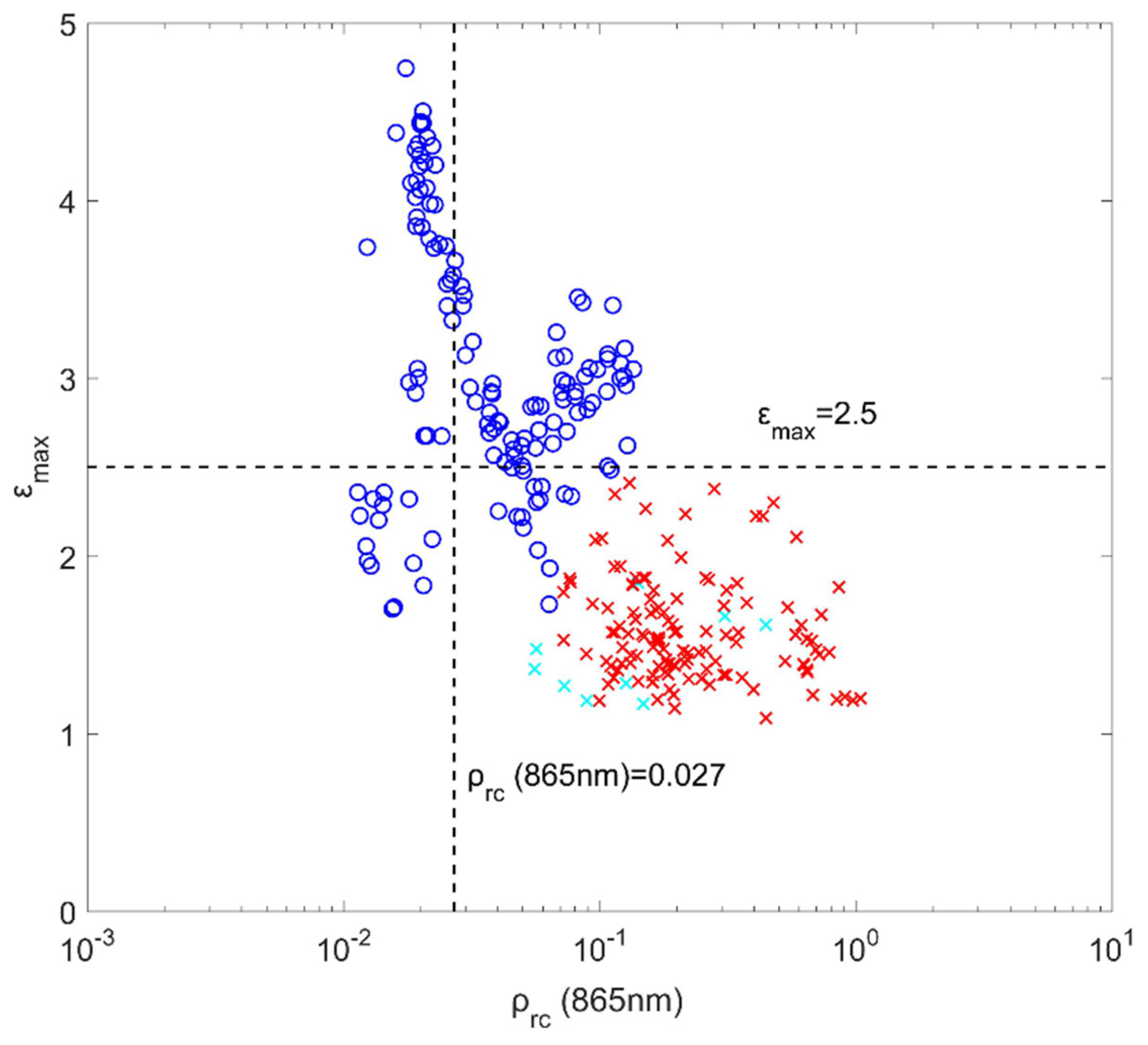
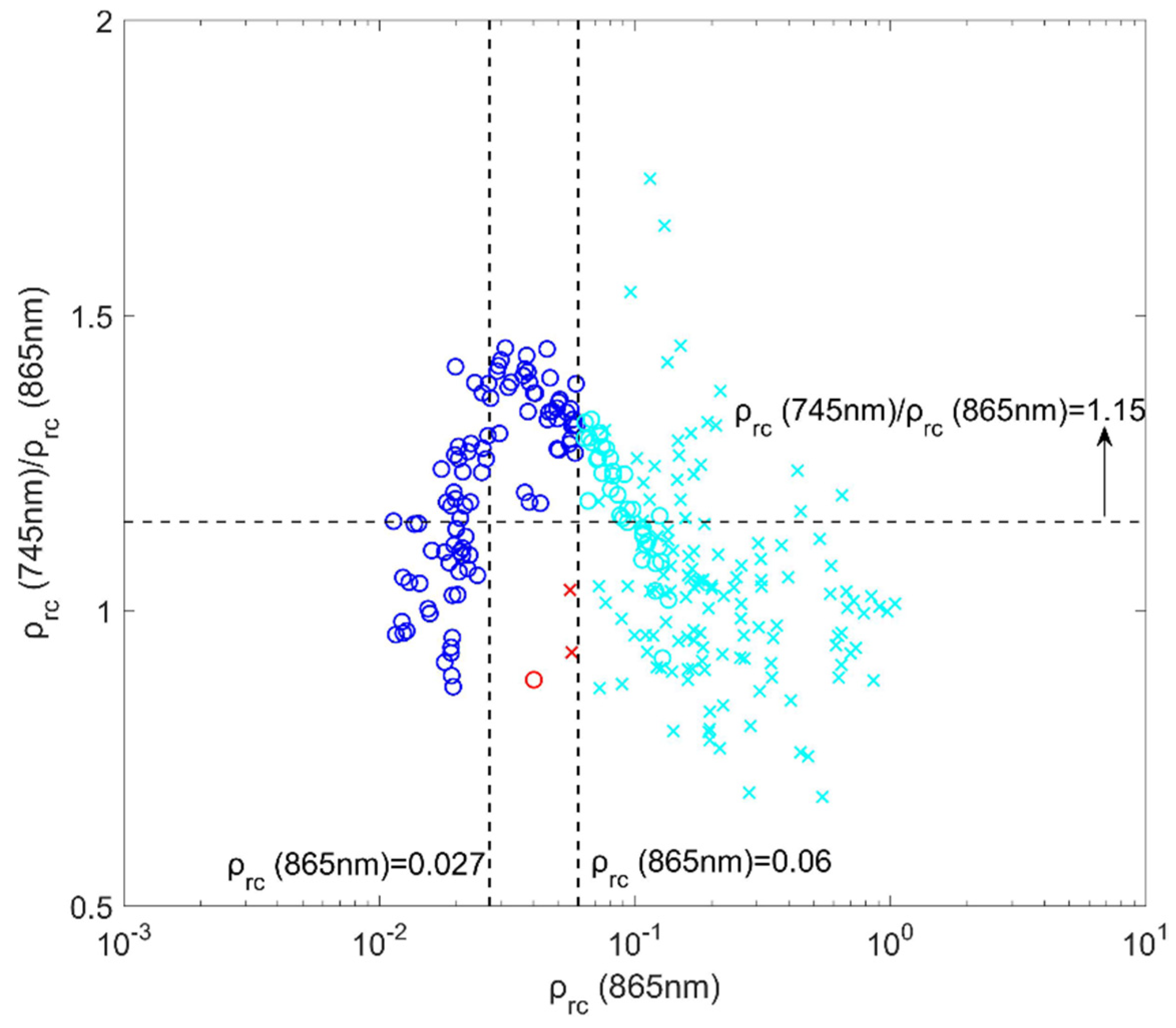
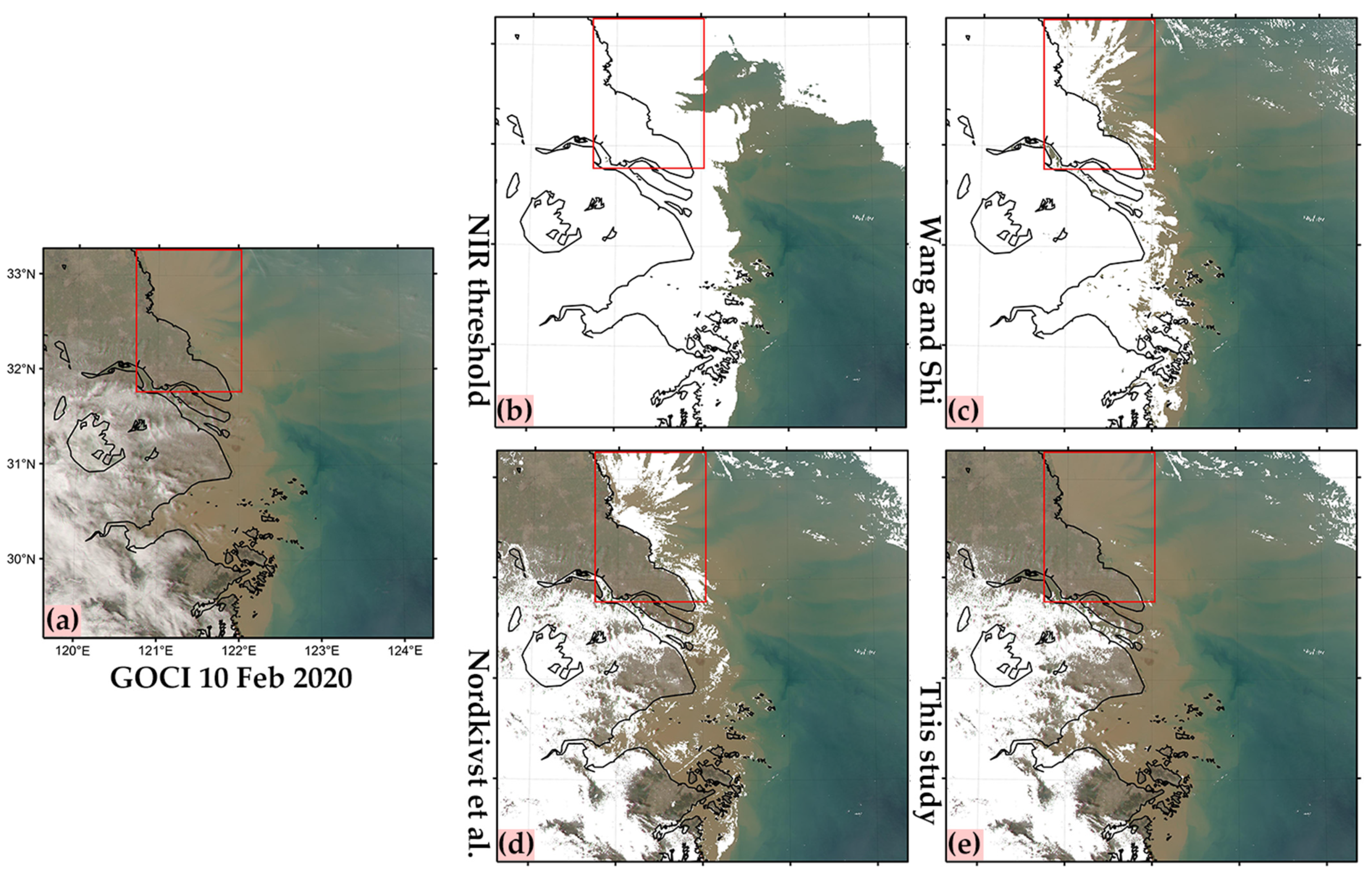
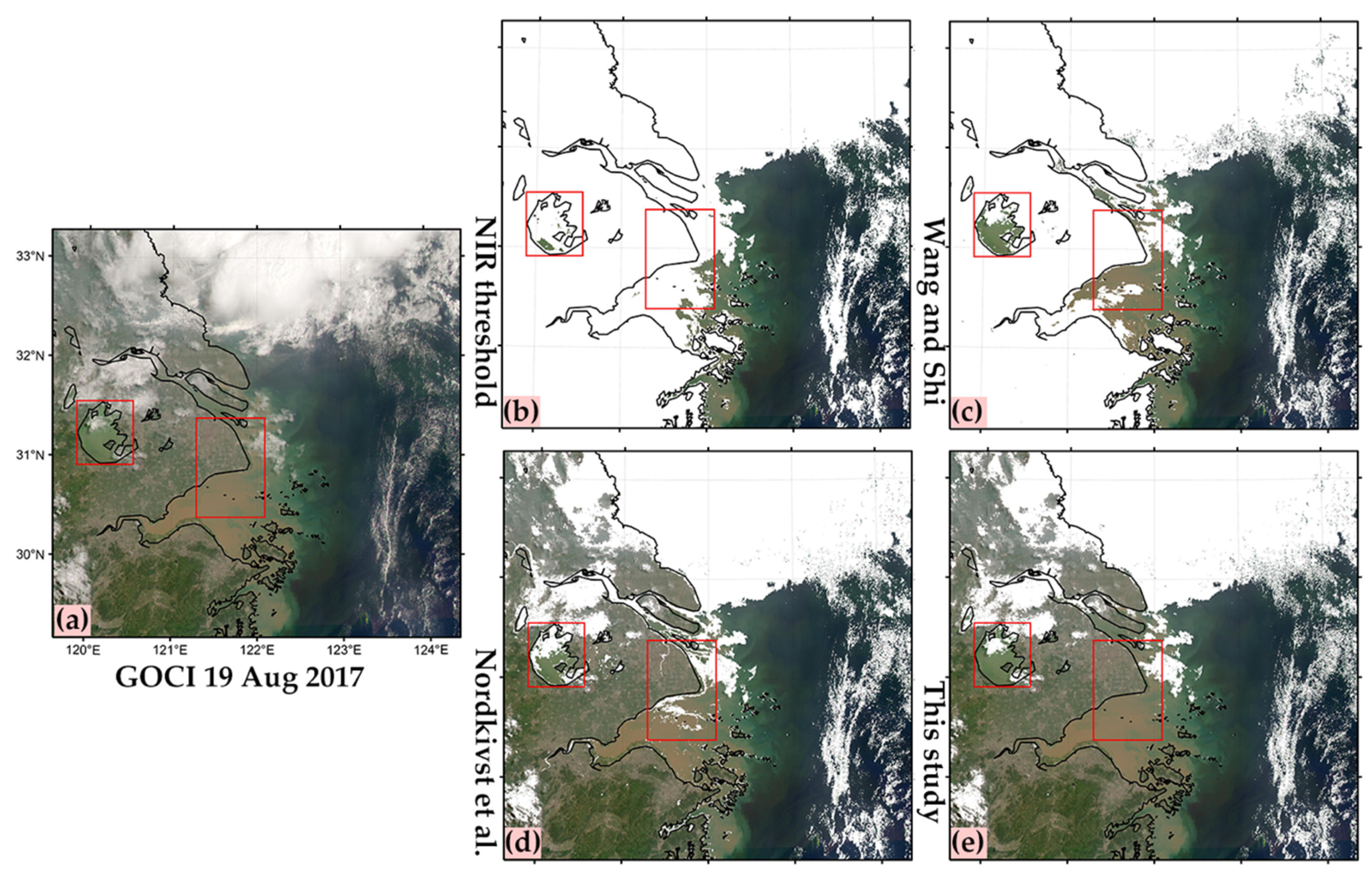
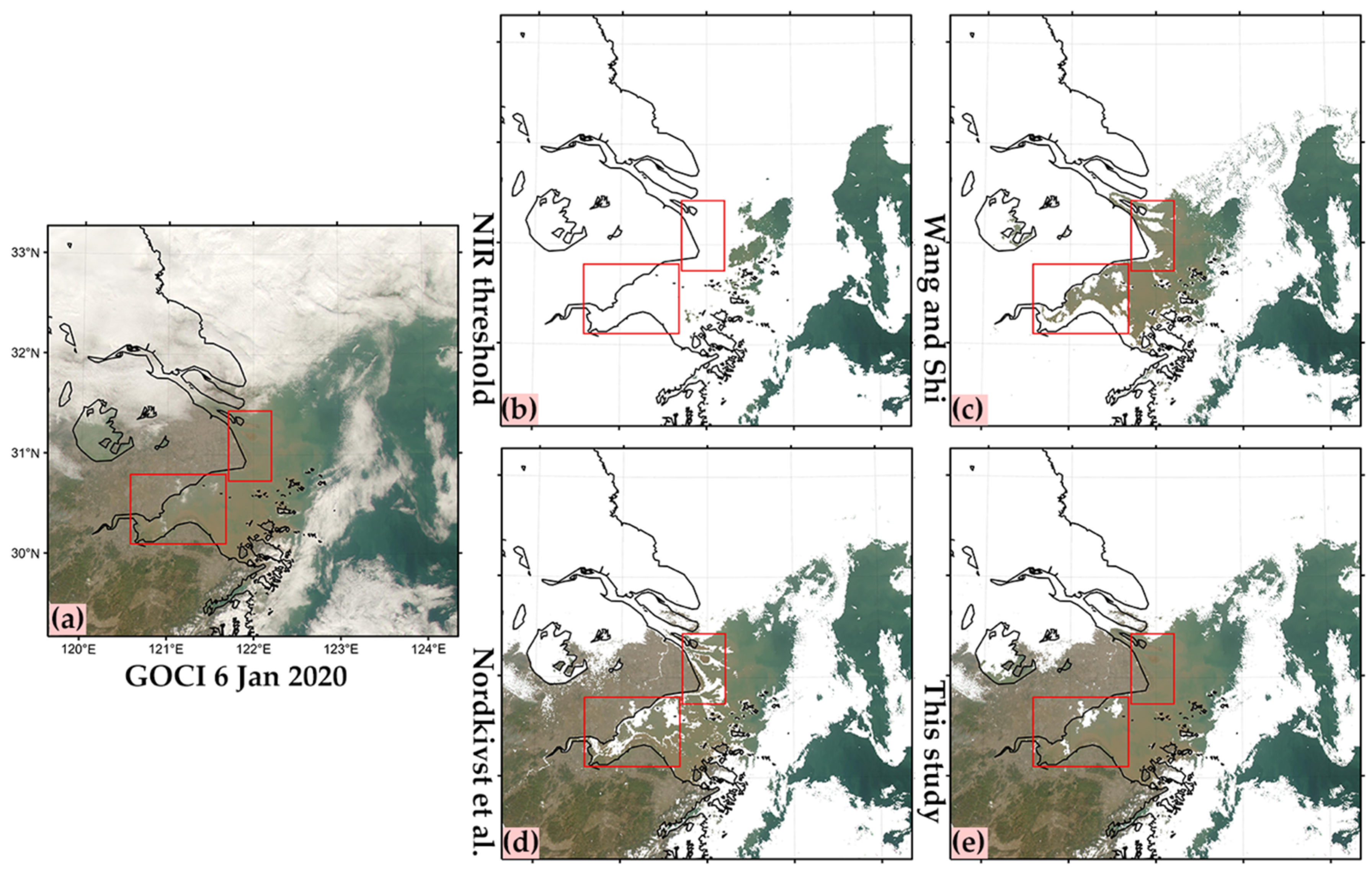
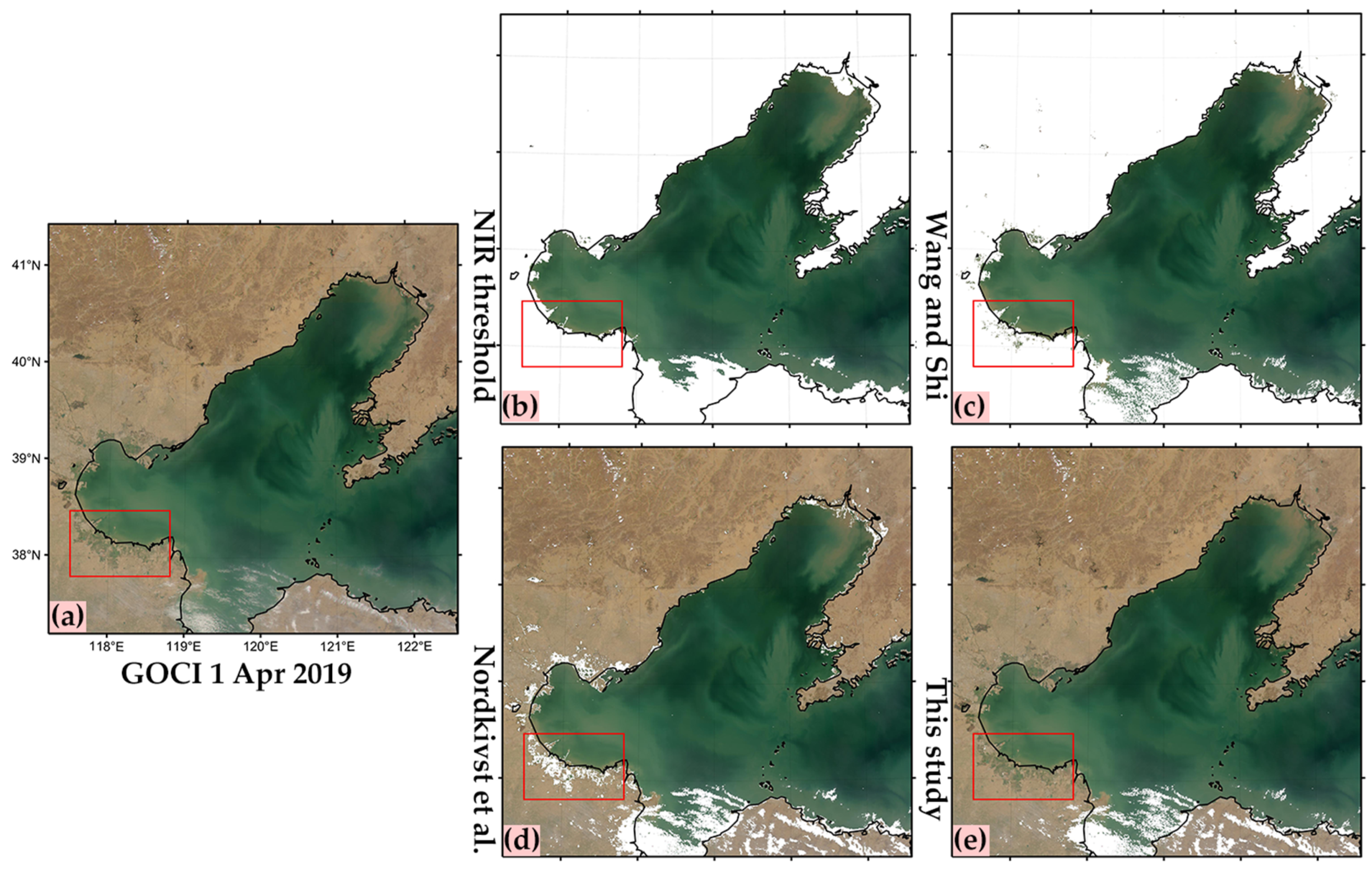
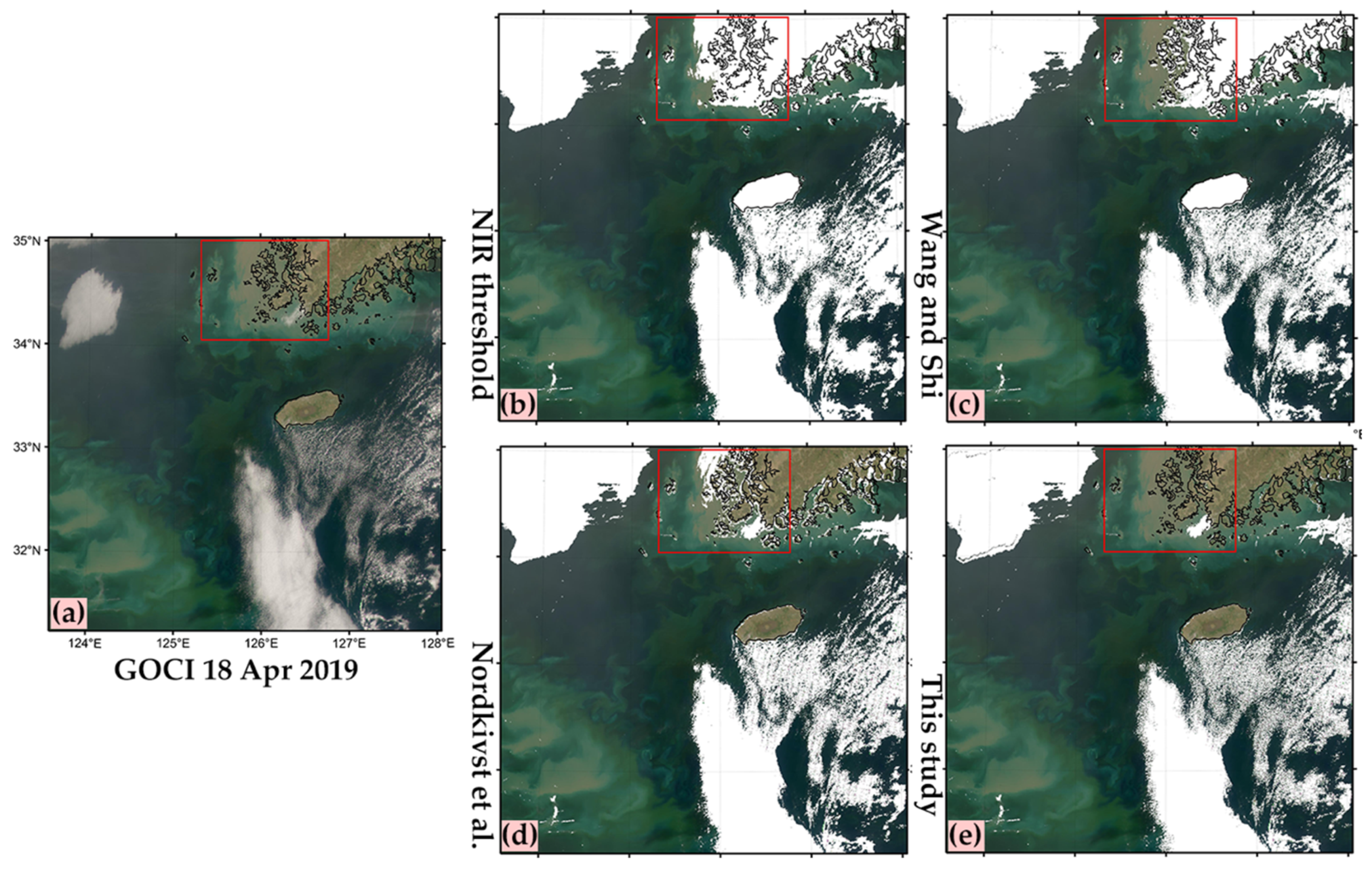
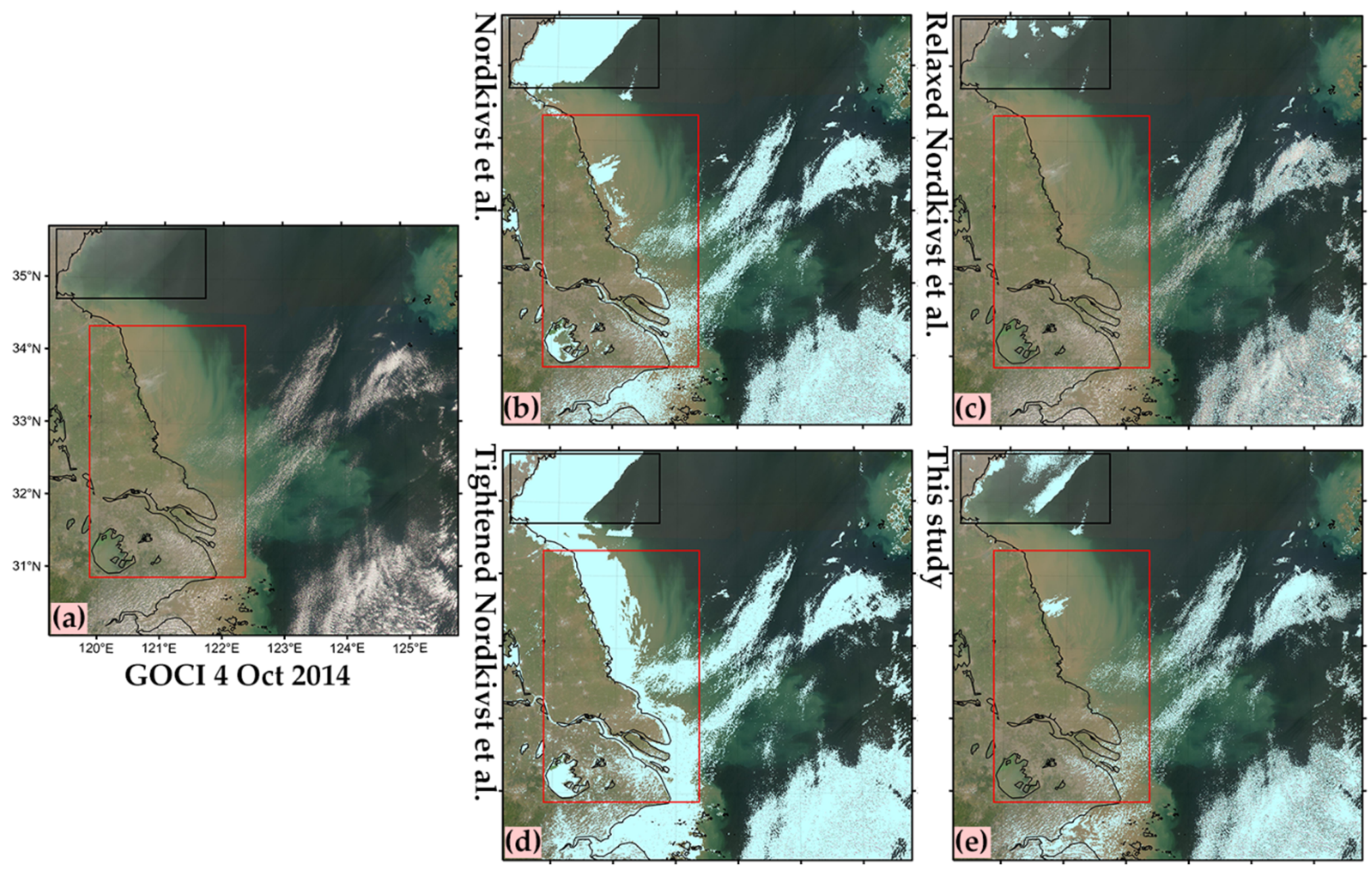

| Region | Date | Total Pixel Number | Clear Pixel Percentage | |||
|---|---|---|---|---|---|---|
| NIR Threshold | Wang and Shi | Nordkvist et al. | This Study | |||
| Lake Tai Hangzhou Bay | 19 August 2017 | 17,952 | 4.23% | 28.67% | 65.61% | 79.77% |
| 35,321 | 9.65% | 40.25% | 82.59% | 94.63% | ||
| Subei coastal | 10 February 2020 | 83,659 | 2.88% | 33.59% | 70.65% | 99.37% |
| Hangzhou Bay Yangtze River | 6 January 2020 | 30,056 | 0.00% | 29.12% | 77.65% | 92.12% |
| 15,836 | 0.01% | 55.41% | 71.47% | 97.95% | ||
| Averaged clear pixel percentage | 3.35% | 37.41% | 73.59% | 92.77% | ||
| Region | Date | Total Pixel Number | Clear Pixel Percentage | |||
|---|---|---|---|---|---|---|
| NIR Threshold | Wang and Shi | Nordkvist et al. | This Study | |||
| Bohai Bay | 1 April 2019 | 31,104 | 31.77% | 36.97% | 85.58% | 99.88% |
| Korean Peninsula | 18 April 2019 | 57,449 | 41.85% | 56.99% | 81.85% | 97.43% |
| Averaged clear pixel percentage | 36.81% | 46.98% | 83.72% | 98.66% | ||
Publisher’s Note: MDPI stays neutral with regard to jurisdictional claims in published maps and institutional affiliations. |
© 2021 by the authors. Licensee MDPI, Basel, Switzerland. This article is an open access article distributed under the terms and conditions of the Creative Commons Attribution (CC BY) license (https://creativecommons.org/licenses/by/4.0/).
Share and Cite
Lu, S.; He, M.; He, S.; He, S.; Pan, Y.; Yin, W.; Li, P. An Improved Cloud Masking Method for GOCI Data over Turbid Coastal Waters. Remote Sens. 2021, 13, 2722. https://doi.org/10.3390/rs13142722
Lu S, He M, He S, He S, Pan Y, Yin W, Li P. An Improved Cloud Masking Method for GOCI Data over Turbid Coastal Waters. Remote Sensing. 2021; 13(14):2722. https://doi.org/10.3390/rs13142722
Chicago/Turabian StyleLu, Shiming, Mingjun He, Shuangyan He, Shuo He, Yunhe Pan, Wenbin Yin, and Peiliang Li. 2021. "An Improved Cloud Masking Method for GOCI Data over Turbid Coastal Waters" Remote Sensing 13, no. 14: 2722. https://doi.org/10.3390/rs13142722
APA StyleLu, S., He, M., He, S., He, S., Pan, Y., Yin, W., & Li, P. (2021). An Improved Cloud Masking Method for GOCI Data over Turbid Coastal Waters. Remote Sensing, 13(14), 2722. https://doi.org/10.3390/rs13142722








